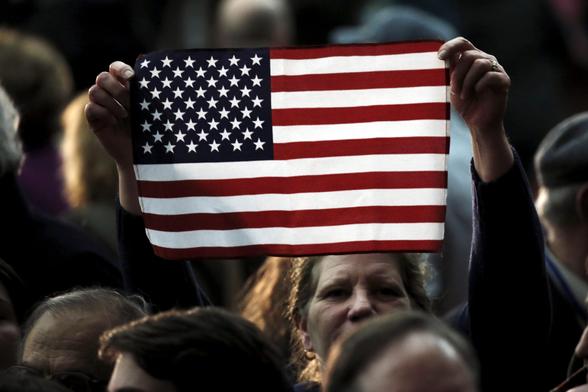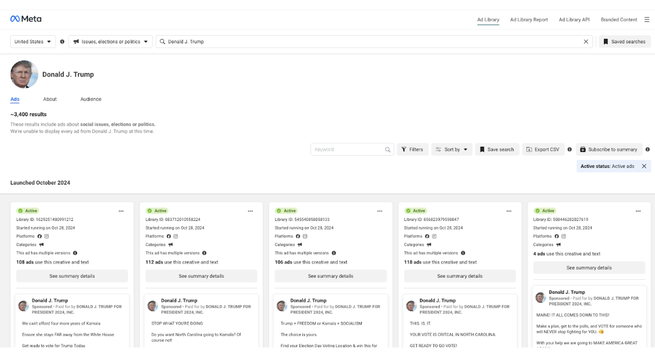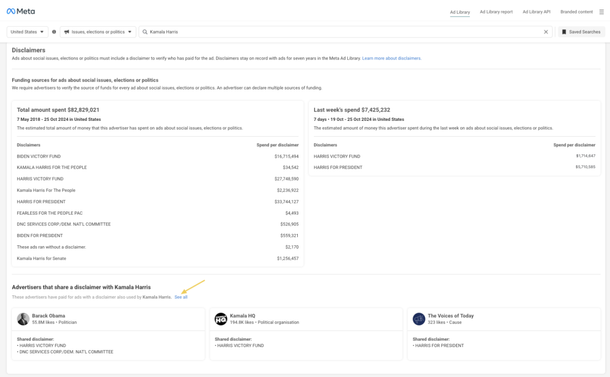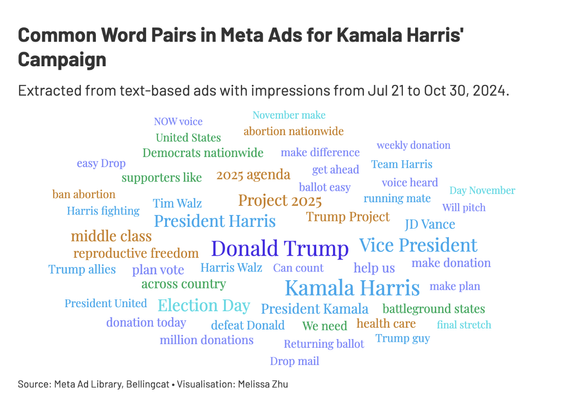In this guide by Pooja Chaudhuri and Melissa Zhu we outline how we used Meta’s free-to-use Ad Library to analyse data about political candidates’ ad spending to get a sense of how they approach digital advertising. https://www.bellingcat.com/resources/2024/11/04/us-presidential-election-trump-harris-meta-ads/?utm_source=mastodon
We break down how we analysed the campaigns of Donald Trump and Kamala Harris and got insights into which states they targeted, their estimated ad spending and some of the key themes that appeared in the ads.
We found that ahead of the 2024 US presidential election on Nov. 5, Democratic candidate Kamala Harris’ campaign mentioned the phrase “Donald Trump” more than they did “Kamala Harris” in ads on Facebook and Instagram.
The Meta Ad Library is a resource that provides details of ad spending across Meta’s platforms – including Facebook, Instagram, the Meta Audience Network and Messenger – in a specific time period.
When looking for an advertiser and the country the ads are targeting, results display all ads that are currently active. But you can tweak the filters to also include ads that ran during the specified time period but are no longer active.
When looking at data for the Democratic and Republican candidates, Harris and Trump’s official accounts respectively were an obvious starting point. However, their campaigns’ spending was not limited to ads running from their official pages.
CNN reported last month, for instance, that the Harris campaign had spent US$11 million on an obscure page called “The Daily Scroll”. https://edition.cnn.com/2024/10/15/politics/daily-scroll-facebook-harris-campaign-ads/index.html
Why the Harris campaign has spent $11 million on a Facebook page with 1,000 followers
As Donald Trump and Kamala Harris feverishly chase undecided voters in the final stretch of the presidential campaign, millions of people in battleground states are being served ads on Facebook and Instagram from an obscure page calling itself “The Daily Scroll.”
A more reliable way to identify ads sponsored by the candidates’ official sponsors is to go to the “About” section on their official accounts, which provides information about all the sponsors associated with that page, as well as other pages that share those sponsors.
Bellingcat downloaded all ads published by pages that share an ad sponsor with the official pages of Harris and Trump. We then removed ads with sponsors not listed on the candidates’ pages, to limit the results to accounts associated with the candidates’ official campaigns.
In total, we found 17 different advertisers with ads sponsored by Harris’ campaign, and six with ads sponsored by Trump’s official campaign.
The files downloaded from the Meta Ad Library includes details on the ads such as the pages and platforms they appeared on, the dates they were created, which states they targeted, a range for the amount spent and the text and links that appeared with each ad.
You can process the data with Python to see the regions that were targeted most by each campaign, or look at the demographic information, showing what percentage of an ad was aimed at a specific gender within different age groups.
The data from Meta’s Ad Library does not show a specific amount of spending for each ad, but rather gives a range with an “upper limit” and “lower limit” reflecting the maximum and minimum amounts spent on the ad respectively.
By summing up the average spending for all ads by each candidate’s campaigns, we found that Harris’ campaign has spent about US$113 million – advertising on Facebook and Instagram between July 21 and Oct. 30, while Trump’s campaign spent about US$17 million.
Almost all (99.8 percent) of the ads sponsored by Harris’ campaign ran on both Facebook and Instagram, whereas almost 26 percent of those supporting Trump were only shown on Facebook, and 7.5 percent targeted only Instagram.
Both figures likely represent just the tip of the iceberg for the candidates’ total ad spending across television and digital advertising including on other online platforms such as Google.
The seven swing states – Arizona, Georgia, Michigan, Nevada, North Carolina, Pennsylvania and Wisconsin – are regarded as holding key positions in the 2024 election. The Democrats have outspent Republicans in each of those states.
To get a rough idea of the key themes in each campaign’s ads on Facebook and Instagram, we used a Python tool that helps break down text into unique word combinations and count them.
The pair of words that appeared most frequently in the Democratic campaign’s ads was “Donald Trump”, with their own nominee’s name following in second place. Harris’ campaign also often mentioned Project 2025 to attack Trump who has been trying to distance himself from the initiative.
Meanwhile, aside from “President Trump” some of the most common keyword pairs in Republican campaign’s ads were “AMERICA GREAT” and “GREAT AGAIN”. This was used in the context of “Make America Great Again”, the slogan popularised by Trump during his 2016 campaign.
@Bellingcat hm. Would jump out at me in comparing the word clouds between the campaigns, is that the Trump campaign is trying to sell things. Like tickets.
The Harris campaign is trying to focus on issues like reproductive freedom.
There’s a fundamental difference when the people running the campaigns see it as a profit center from which to extract money — as opposed to a contest that they are trying to win #grift #Susie_wiles





